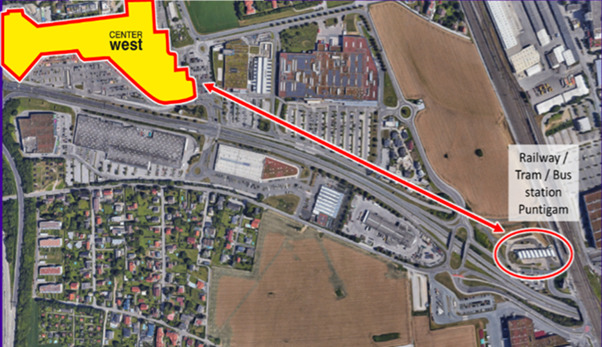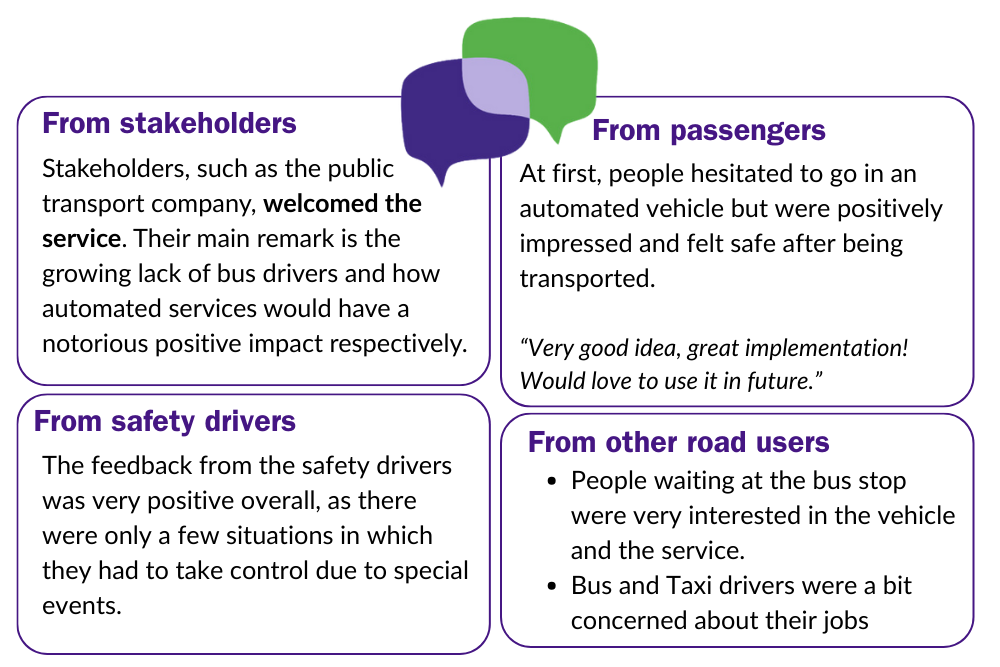Mega sites

AUSTRIA
CARINTHIA
Automated shuttles for passenger and cargo transport in a complex traffic environment
Vision
The Carinthia pilot offers a first and last-mile solution to enhance existing public transport through automated shuttles, integrating Cooperative, Connected, and Automated Mobility (CCAM) to reduce individual car use. The project features an on-demand service that boosts operational efficiency while combining passenger and cargo transport. It focuses on optimizing the passenger experience in automated shuttles and enhancing the safety of vulnerable road users (VRUs) using V2X technology (C-ITS). Two key locations are included in the pilot, Pörtschach and Klagenfurt providing essential connectivity and accessibility within the region’s transport network.
The Service
- Service fully integrated into PT
- Service online bookable via booking platforms
- Operates with a 20-minutes interval from 09:30/10 am to 4 pm on 5 days a week
- Free of charge
- Safety driver on board
- On-demand service 2024
Fleet
- 1 Navya Arma DL4 shuttle
- 2 more Navya Arma DL4 shuttles 2024
Target Passengers
Tourists, commuters, residents
The Route
The Pörtschach route is a 2.7 km connection with 8 bus stops linking the train station to the lake, hotels, and town centre, featuring no traffic lights and two left turns.

The Klagenfurt route is 4 km long with 18 bus stops, connecting the train station to the university and key destinations

Key Feedback

Challenges & Recommendations

Use Cases
- UC 1.1 Automated passenger/cargo mobility in cities under normal traffic & environmental conditions
- UC 1.2 Automated passenger/cargo mobility in cities under complex traffic & environmental conditions
- UC 1.6 Mixed traffic flows, modes addressed: PT as a minimum
- UC 2.1 Automated mixed spatial mobility (passengers & parcel service)
- UC 3.2 Big data/AI based added value services for passengers/cargo mobility
- UC 3.6 COVID-19 safe transport
Local Ecosystem

Legacy
The Carinthia pilot leaves a valuable legacy, as the C-ITS infrastructure developed will be utilized by KMG, the public transport provider, to prioritize public bus operations effectively. With an increasing workforce shortage, transportation companies recognize the necessity of automated vehicles. Plans for expansion into other regions are underway, accompanied by ongoing development of functionalities. This initiative not only enhances business models but also facilitates the transfer of knowledge and expertise, paving the way for a more efficient and sustainable public transport system.
SALZBURG
Automated passenger transport service on the first-/last-mile in a peri-urban area

Vision
The Service
- Free of charge
- Serving 7 stops on a fixed route (2.8 km)
- Safety driver on board
- 5 days a week (Mo-Fr)
- Complementing the existing public transport
- Shortening the cycle time
- Connection to mobility hub
Fleet
- 1 autonomous shuttle (HEAT) – L4
- 1 VW e-Crafter (automated, fully electric) – L4
Target Passengers
Commuters, tourists, locals, anybody interested in automated mobility
The Route

7 stops along a 2.8 km fixed track between Koppl Sperrbrücke and Koppl Am Weberbach.
Key Feedback

Challenges & Recommendation

Use Cases
UC1.2 (complex conditions)
UC1.3 (interfacing other road users)
UC1.5 (integration to city TMC)
UC 1.6 (mixed traffic flows)
UC 3.1 (self-learning DRT)
Local Ecosystem
![SALZBURG_Ecosystem[1]](https://show-project.eu/wp-content/uploads/2024/11/SALZBURG_Ecosystem1.png)
Legacy
The Salzburg pilot aligned with the province’s mobility and Science and Innovation Strategy 2025. Continued testing of automated vehicles was key to raising public awareness and confidence, demonstrating that automated shuttles are a reality. However, the pilot highlighted the technology’s current limitations, as fully autonomous first-/last-mile services are not yet feasible. As technology matures, it could improve public transport coverage and reduce private car use, but integration into transport systems and fare models is essential. First-/last-mile transport, especially in rural areas, remains a priority, with lessons from the SHOW project guiding future options.
GRAZ
Automated Mobility as a Complement of Public Transport in Graz
Vision
The Graz pilot focuses on integrating CCAM solutions to support the city’s vision of minimizing individual car use. By implementing shared CCAM services, the project aims to enhance access to key destinations, including shopping centres. A key aspect of this pilot is the smart integration of infrastructure at the bus terminal, which facilitates seamless transfers between automated services and traditional public transport. Additionally, automated curb management systems are employed to optimize the use of bus bays, improving overall efficiency and user experience in the city’s transport network.
The Service
- Free of charge
- Safety driver on board
- No prior booking // ride on the spot
- Passengers can notify their end destination once they get on-board though a tablet
- No remote supervision
- C-ITS is used to optimize the trips, but the service is not dependent on it
Fleet
- 1 Ford Fusion (passenger car), L4, hybrid
- 1 Kia e-Soul (passenger car), L4, electric
Target Passengers
Any interested passenger, from commuters to passers-by
The Route

Two automated shuttles run between a suburban train station in Graz and a shopping centre, covering about 2 km to pick up passengers at the terminal.
Key Feedback

Challenges & Recommendations

Use Cases
UC1.2 (complex conditions)
UC1.3 (interfacing other road users)
UC1.4 (energy sustainable)
Local Ecosystem
